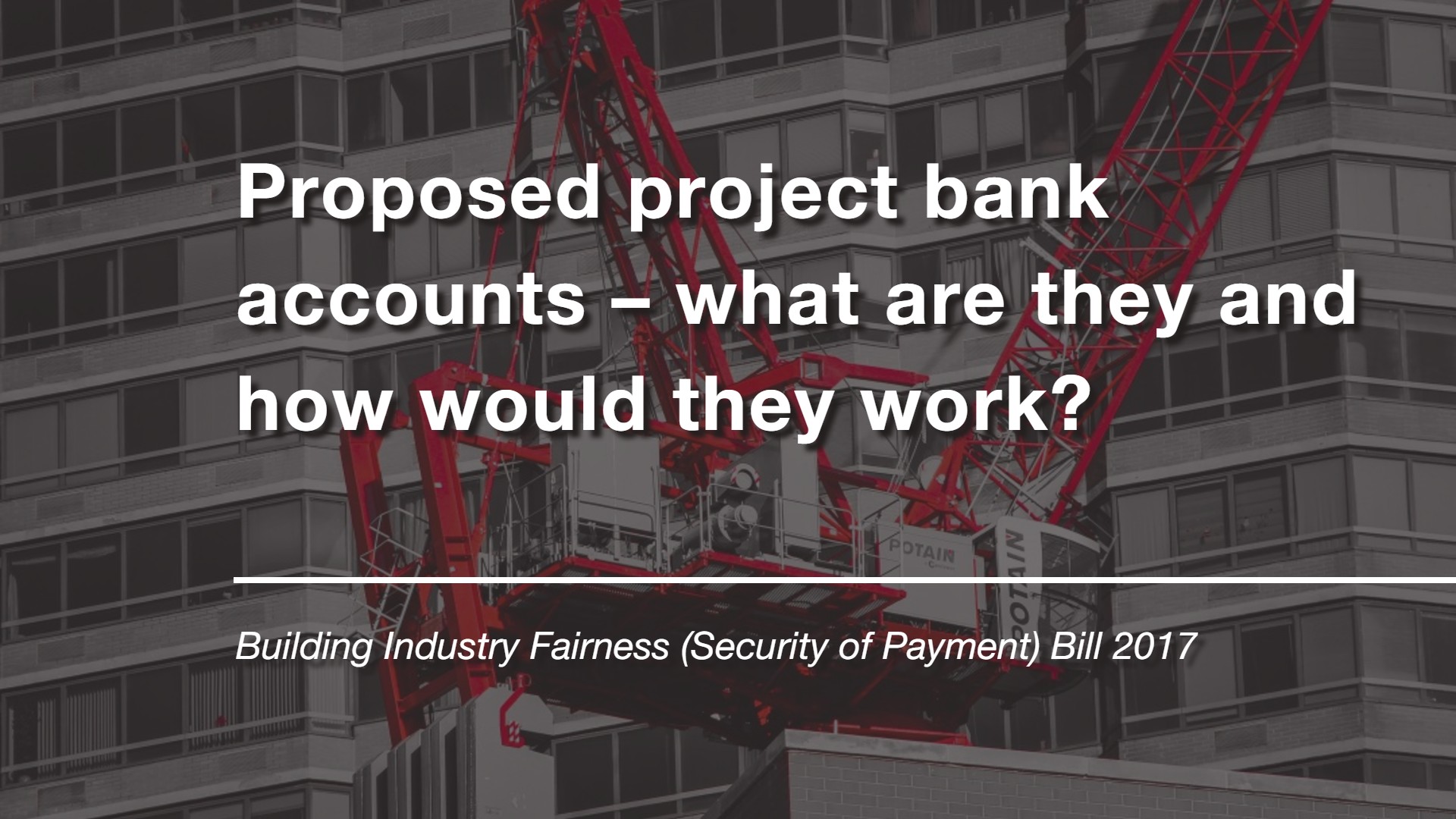Our previous update outlined the significant changes proposed by the Queensland government in the Building Industry Fairness (Security of Payment) Bill 2017 (the Bill). Most significantly, the Bill proposed the introduction of Project Bank Accounts (PBAs).
Objective
The objective of a PBA is to quarantine progress payments into a trust account to ensure subcontractors are paid, and to provide greater protection in the event of the insolvency of a head contractor.
When?
PBAs are planned to be implemented in two phases, being:
- Phase 1: on and from 1 January 2018, PBAs will be required on all State government and State authority building and construction projects between $1 million and $10 million; and
- Phase 2:on and from 1 January 2019, PBAs will be required on all building and construction projects in excess of $1 million.
Phases 1 and 2 will apply to first tier subcontractors; that is, subcontractors contracting directly with the head contractor.
It is anticipated that supplementary prescribed regulations will be enacted following the initial Phase 1 teething period. The Bill enables application of PBAs to lower tier subcontractors at a later date as prescribed by regulation.
What type of work?
PBAs will not be required for subcontracts on engineering or infrastructure projects, including bridges, roads and ports, or contracts for maintenance work. However, PBAs will be required for all other building work as defined.
Subcontracts for the supply of plant or materials, manufactured or modified such that they are project specific materials, will also come within the definition.
How do they work?
Head contractors will be required to establish a PBA for projects within:
- 20 business days of entering into the first subcontract for a project; or
- if a subcontract is entered before the head contract, within 10 business days of entering the head contract.
Each PBA must be comprised of:
- a general trust account, in which payments by the principal will be deposited, and from which the head contractor will pay itself and its subcontractors;
- a retention trust account, where subcontractor retention monies are held; and
- a disputed funds account, where monies subject to a payment dispute must be transferred, from the general trust account, by the head contractor as soon as it becomes aware of the dispute (i.e. the difference between the ‘instructed amount’ given to the financial institution and the amount stated in the payment schedule).
The legislation seems to assume that the payment instruction to the financial institution will specify an instructed amount for each individual subcontractor.
Principals must make all payments into the general trust account.
Funds can only be withdrawn to firstly pay subcontractors, and only thereafter to pay the head contractor.
If a head contractor knows there will be an insufficient amount in a PBA to satisfy payment of any subcontractor, it must immediately deposit funds into the PBA to cover the shortfall.
What is not clear is what does “payment” mean?
What happens if the principal does not pay the contractor? Or rejects a contractor’s claim that includes a variation from a subcontractor? It seems the contractor must still cover that shortfall.
Withdrawal of trust funds
Withdrawals from the PBA can only be made via a payment instruction given to the financial institution by the head contractor and only by way of electronic transfer.
The head contractor must ensure that the principal can view:
- payment instructions;
- deposits into the PBA; and
- account payment reports.
As soon as practicable after giving a payment instruction, the head contractor must provide the principal, and any subcontractor being paid, a copy of the payment instruction.
Interest on PBAs
Head contractors will be entitled to all of the interest earned on funds in the PBA, but cannot invest the funds in the account. The interest accrued can only be withdrawn once every 12 months, or on dissolution of the PBA.
Termination
PBAs can only be closed after all subcontractors have been paid in full and the only remaining work is maintenance work.
What is not clear is what paid in full means? What if the disputed payment is on appeal to a Court?
If the head contract is terminated or the head contractor becomes insolvent, the principal may give notice to the head contractor (or liquidator) advising that it will replace the head contractor as trustee of the PBA. The principal becomes the trustee of the PBA from the day notice is given. Where this occurs, the head contractor will not be relieved of its duty to cover any shortfall in the PBA, but continues to be a beneficiary of the PBA and continues to be entitled to the interest earned.
Subcontractor’s priority
The head contractor must not withdraw an amount from the PBA to pay itself or make other payments prescribed by regulation until amounts payable to subcontractors are paid in full. Again, when is the subcontractor paid in full? Is the head contractor’s cash flow for the disputed amount frozen until an appeal is heard?
How then does the head contractor pay GST, BAS and other statutory payments if they are not payments prescribed by regulation? Out of its general overdraft rather than the general trust account for the project?
In the event of insolvency, a PBA interest has priority over all secured and unsecured interests, including those registered under the Personal Property Securities Act 2009 (Cth).
Short term contracts exempt
PBAs will not be required if there is less than 90 days between the PBA establishment date and date for practical completion for the head contract.
Procedural requirements
The additional procedural requirements imposed on head contractors include:
- opening three separate trust accounts under a name including ‘trust account’ for each project;
- giving the principal written notice within 10 business days of opening the PBA, changing the name of any of the trust accounts, or closing of the PBA;
- giving notice in the approved form to a subcontractor of the applicability of the PBA before entering the subcontract;
- within 5 business days of establishing a PBA, giving the principal prescribed information about subcontractors; and
- keeping written records of all PBA transactions.
Head contractors will be entitled to employ agents to administer PBAs, but will not be entitled to payment for the administration of PBAs or bank fees incurred.
Principal’s obligations
The Bill imposes obligations on principals to report any discrepancies in a payment instruction to the commissioner as soon as practicable after becoming aware. Reportable discrepancies include:
- an error in the account number for a subcontractor beneficiary;
- payment to an entity not permitted by the Bill; and
- payment to a subcontractor which does not match the account name.
Penalties apply for non-compliance.
Penalties for non-compliance
The Bill imposes significant monetary and imprisonment penalties for non-compliance.
For example, a failure to properly establish a PBA may incur fines of more than $60,000. Further, if a head contractor misappropriates monies held in a PBA, penalties of up to 2 years imprisonment apply.
CDI breakfast seminar
See link to our seminar on this Bill on Thursday, 5 October 2017 – numbers are limited.
This publication does not deal with every important topic or change in law and is not intended to be relied upon as a substitute for legal or other advice that may be relevant to the reader’s specific circumstances. If you have found this publication of interest and would like to know more or wish to obtain legal advice relevant to your circumstances please contact one of the named individuals listed.



